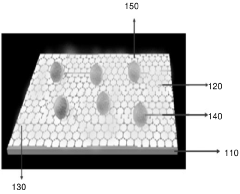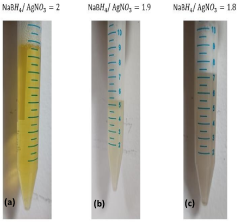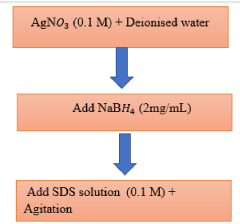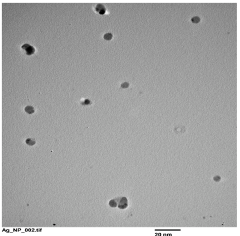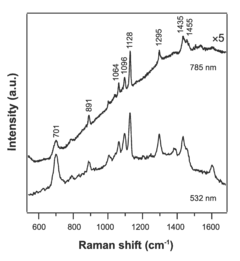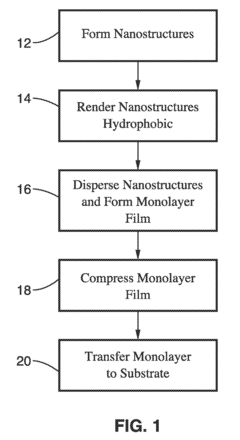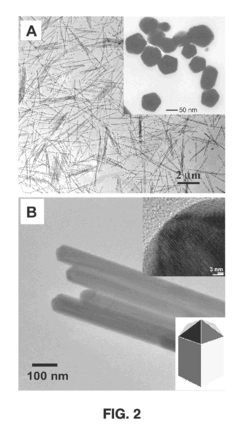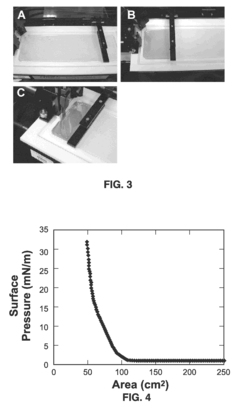Effects of SERS Substrates on Polymer Conformation Detection
OCT 11, 202510 MIN READ
Generate Your Research Report Instantly with AI Agent
Patsnap Eureka helps you evaluate technical feasibility & market potential.
SERS Substrate Technology Background and Objectives
Surface-Enhanced Raman Spectroscopy (SERS) has evolved significantly since its discovery in the 1970s, revolutionizing molecular detection capabilities through enhanced Raman signals. The technology leverages the interaction between light and metallic nanostructures to amplify Raman scattering signals by factors of 10^6 to 10^14, enabling single-molecule detection in optimal conditions. This remarkable sensitivity has positioned SERS as a powerful analytical technique across multiple scientific disciplines, from chemistry and materials science to biomedical applications and environmental monitoring.
The development of SERS substrate technology has progressed through several distinct phases. Early research focused on roughened metal electrodes and colloidal solutions, while recent advancements have introduced highly engineered substrates with precisely controlled nanostructures. These modern substrates incorporate sophisticated designs including nanospheres, nanorods, nanostars, and hierarchical structures that optimize the generation of "hot spots" - regions of intense electromagnetic field enhancement critical for SERS performance.
Polymer conformation detection represents a particularly challenging yet promising application area for SERS technology. Polymers, with their complex three-dimensional structures and conformational dynamics, require specialized detection approaches to accurately characterize their properties and behaviors. Traditional analytical methods often struggle to provide detailed conformational information without altering the polymer structure during analysis.
The primary objective of SERS substrate technology in polymer conformation detection is to develop highly sensitive, reproducible, and selective platforms capable of non-destructively probing polymer structures at the molecular level. This includes monitoring conformational changes under various environmental conditions, detecting specific functional groups, and characterizing polymer-surface interactions with minimal interference.
Current research aims to address several key technical goals: enhancing signal reproducibility across substrate batches, improving detection limits for complex polymer systems, developing substrate architectures specifically optimized for polymer analysis, and creating standardized protocols for data interpretation. Additionally, there is significant interest in designing SERS substrates that can function effectively in diverse environmental conditions relevant to polymer applications, such as varying pH, temperature, and solvent environments.
The convergence of nanotechnology, materials science, and spectroscopic techniques has accelerated innovation in this field, with interdisciplinary collaboration driving rapid advances. Looking forward, the evolution of SERS substrate technology for polymer analysis is expected to continue along trajectories that emphasize greater specificity, enhanced signal stability, expanded application range, and integration with complementary analytical techniques to provide comprehensive polymer characterization capabilities.
The development of SERS substrate technology has progressed through several distinct phases. Early research focused on roughened metal electrodes and colloidal solutions, while recent advancements have introduced highly engineered substrates with precisely controlled nanostructures. These modern substrates incorporate sophisticated designs including nanospheres, nanorods, nanostars, and hierarchical structures that optimize the generation of "hot spots" - regions of intense electromagnetic field enhancement critical for SERS performance.
Polymer conformation detection represents a particularly challenging yet promising application area for SERS technology. Polymers, with their complex three-dimensional structures and conformational dynamics, require specialized detection approaches to accurately characterize their properties and behaviors. Traditional analytical methods often struggle to provide detailed conformational information without altering the polymer structure during analysis.
The primary objective of SERS substrate technology in polymer conformation detection is to develop highly sensitive, reproducible, and selective platforms capable of non-destructively probing polymer structures at the molecular level. This includes monitoring conformational changes under various environmental conditions, detecting specific functional groups, and characterizing polymer-surface interactions with minimal interference.
Current research aims to address several key technical goals: enhancing signal reproducibility across substrate batches, improving detection limits for complex polymer systems, developing substrate architectures specifically optimized for polymer analysis, and creating standardized protocols for data interpretation. Additionally, there is significant interest in designing SERS substrates that can function effectively in diverse environmental conditions relevant to polymer applications, such as varying pH, temperature, and solvent environments.
The convergence of nanotechnology, materials science, and spectroscopic techniques has accelerated innovation in this field, with interdisciplinary collaboration driving rapid advances. Looking forward, the evolution of SERS substrate technology for polymer analysis is expected to continue along trajectories that emphasize greater specificity, enhanced signal stability, expanded application range, and integration with complementary analytical techniques to provide comprehensive polymer characterization capabilities.
Market Analysis for SERS-based Polymer Detection
The SERS-based polymer detection market is experiencing significant growth, driven by increasing demand for advanced analytical techniques in materials science, pharmaceuticals, and biotechnology. The global market for SERS technology was valued at approximately $1.2 billion in 2022 and is projected to reach $2.5 billion by 2028, with a compound annual growth rate of 12.8%. Within this broader market, polymer analysis applications represent a rapidly expanding segment, currently estimated at $350 million.
Key market drivers include the growing need for precise characterization of polymer structures in various industries, particularly in quality control processes for polymer manufacturing. The pharmaceutical sector represents the largest end-user segment, accounting for nearly 35% of the market share, followed by materials science research at 28% and biotechnology at 20%. This distribution reflects the critical importance of polymer conformation analysis in drug delivery systems and biocompatible materials development.
Regional analysis indicates that North America currently dominates the market with approximately 40% share, followed by Europe (30%) and Asia-Pacific (25%). However, the Asia-Pacific region is expected to witness the fastest growth rate over the next five years due to increasing industrialization and research investments in countries like China, Japan, and South Korea.
The customer base for SERS-based polymer detection technologies is primarily composed of research institutions (45%), pharmaceutical companies (30%), and materials manufacturing firms (15%). These customers are increasingly demanding more sensitive, reliable, and user-friendly SERS substrates that can provide detailed information about polymer conformations under various environmental conditions.
Market challenges include the high cost of advanced SERS substrates, technical complexity requiring specialized expertise, and competition from alternative analytical techniques such as FTIR and NMR spectroscopy. The average cost of commercial SERS substrates ranges from $200 to $1,000 per unit, which can be prohibitive for smaller research facilities and companies.
Emerging market opportunities include the development of portable SERS devices for on-site polymer analysis, integration with artificial intelligence for automated data interpretation, and application-specific SERS substrates optimized for particular polymer types. The market for portable SERS devices alone is expected to grow at 18% annually, reaching $400 million by 2027.
Customer feedback indicates growing interest in SERS substrates that offer enhanced reproducibility, longer shelf life, and simplified sample preparation protocols. These market insights suggest that future product development should focus on addressing these specific customer needs while reducing overall implementation costs.
Key market drivers include the growing need for precise characterization of polymer structures in various industries, particularly in quality control processes for polymer manufacturing. The pharmaceutical sector represents the largest end-user segment, accounting for nearly 35% of the market share, followed by materials science research at 28% and biotechnology at 20%. This distribution reflects the critical importance of polymer conformation analysis in drug delivery systems and biocompatible materials development.
Regional analysis indicates that North America currently dominates the market with approximately 40% share, followed by Europe (30%) and Asia-Pacific (25%). However, the Asia-Pacific region is expected to witness the fastest growth rate over the next five years due to increasing industrialization and research investments in countries like China, Japan, and South Korea.
The customer base for SERS-based polymer detection technologies is primarily composed of research institutions (45%), pharmaceutical companies (30%), and materials manufacturing firms (15%). These customers are increasingly demanding more sensitive, reliable, and user-friendly SERS substrates that can provide detailed information about polymer conformations under various environmental conditions.
Market challenges include the high cost of advanced SERS substrates, technical complexity requiring specialized expertise, and competition from alternative analytical techniques such as FTIR and NMR spectroscopy. The average cost of commercial SERS substrates ranges from $200 to $1,000 per unit, which can be prohibitive for smaller research facilities and companies.
Emerging market opportunities include the development of portable SERS devices for on-site polymer analysis, integration with artificial intelligence for automated data interpretation, and application-specific SERS substrates optimized for particular polymer types. The market for portable SERS devices alone is expected to grow at 18% annually, reaching $400 million by 2027.
Customer feedback indicates growing interest in SERS substrates that offer enhanced reproducibility, longer shelf life, and simplified sample preparation protocols. These market insights suggest that future product development should focus on addressing these specific customer needs while reducing overall implementation costs.
Current SERS Substrate Challenges in Polymer Analysis
Despite significant advancements in Surface-Enhanced Raman Spectroscopy (SERS) technology, several critical challenges persist in the application of SERS substrates for polymer conformation detection. The primary limitation lies in achieving consistent enhancement factors across the substrate surface. Current commercial and laboratory-prepared substrates often exhibit "hot spots" - localized areas of extremely high enhancement surrounded by regions of minimal activity. This spatial heterogeneity severely impacts reproducibility and quantitative analysis capabilities when examining polymer conformational changes.
Substrate stability presents another significant hurdle, particularly for time-dependent polymer studies. Many high-performance SERS substrates degrade rapidly under experimental conditions, with silver-based substrates being especially prone to oxidation and gold nanostructures susceptible to morphological changes during prolonged exposure to laser excitation or chemical environments. This instability compromises the reliability of measurements when monitoring polymer conformational dynamics over extended periods.
The interface compatibility between SERS substrates and polymer samples remains problematic. Most substrates are optimized for small molecule detection rather than macromolecular analysis. The physical and chemical interactions between polymers and substrate surfaces can induce artificial conformational changes, potentially leading to misinterpretation of results. Current substrate designs rarely account for these polymer-specific interactions, creating significant analytical artifacts.
Signal interference from the substrate itself constitutes another major challenge. Many substrate materials contribute background signals that overlap with polymer spectral features. This is particularly problematic for detecting subtle conformational changes in polymers, where small spectral shifts or intensity variations carry critical structural information. The background contribution often necessitates complex computational processing that can introduce additional uncertainties.
Scale-dependent enhancement effects further complicate polymer analysis. While SERS provides excellent sensitivity for detecting local chemical environments, polymer conformational analysis requires consistent enhancement across different spatial scales - from individual functional groups to overall chain arrangements. Current substrates rarely deliver uniform enhancement across these multiple dimensional scales, limiting comprehensive conformational analysis.
Finally, there exists a significant knowledge gap in understanding how different substrate architectures specifically affect polymer conformation detection. Most SERS substrate development has focused on small molecule sensing applications, with limited systematic studies on polymer-specific requirements. This has resulted in a lack of design principles for creating substrates optimized for polymer conformational analysis, hampering progress in this important application area.
Substrate stability presents another significant hurdle, particularly for time-dependent polymer studies. Many high-performance SERS substrates degrade rapidly under experimental conditions, with silver-based substrates being especially prone to oxidation and gold nanostructures susceptible to morphological changes during prolonged exposure to laser excitation or chemical environments. This instability compromises the reliability of measurements when monitoring polymer conformational dynamics over extended periods.
The interface compatibility between SERS substrates and polymer samples remains problematic. Most substrates are optimized for small molecule detection rather than macromolecular analysis. The physical and chemical interactions between polymers and substrate surfaces can induce artificial conformational changes, potentially leading to misinterpretation of results. Current substrate designs rarely account for these polymer-specific interactions, creating significant analytical artifacts.
Signal interference from the substrate itself constitutes another major challenge. Many substrate materials contribute background signals that overlap with polymer spectral features. This is particularly problematic for detecting subtle conformational changes in polymers, where small spectral shifts or intensity variations carry critical structural information. The background contribution often necessitates complex computational processing that can introduce additional uncertainties.
Scale-dependent enhancement effects further complicate polymer analysis. While SERS provides excellent sensitivity for detecting local chemical environments, polymer conformational analysis requires consistent enhancement across different spatial scales - from individual functional groups to overall chain arrangements. Current substrates rarely deliver uniform enhancement across these multiple dimensional scales, limiting comprehensive conformational analysis.
Finally, there exists a significant knowledge gap in understanding how different substrate architectures specifically affect polymer conformation detection. Most SERS substrate development has focused on small molecule sensing applications, with limited systematic studies on polymer-specific requirements. This has resulted in a lack of design principles for creating substrates optimized for polymer conformational analysis, hampering progress in this important application area.
Current Methodologies for Polymer Conformation Detection
01 Polymer-based SERS substrates
Polymer materials can be used as substrates for Surface-Enhanced Raman Spectroscopy (SERS). These polymer-based SERS substrates offer advantages such as flexibility, cost-effectiveness, and ease of fabrication. The polymer matrix can be designed to incorporate metal nanoparticles or nanostructures that provide the plasmonic enhancement necessary for SERS. The conformation of the polymer chains can be controlled to optimize the distribution and arrangement of the enhancing structures, leading to improved SERS performance.- Polymer-based SERS substrates: Polymer materials can be used as substrates for Surface-Enhanced Raman Spectroscopy (SERS). These polymer-based SERS substrates offer advantages such as flexibility, cost-effectiveness, and ease of fabrication. The polymer conformation can be controlled to optimize the SERS enhancement effect. Various polymers including conductive polymers and polymer nanocomposites can be utilized to create effective SERS platforms with tunable properties.
- Nanostructured polymer conformations for SERS: Nanostructured polymer conformations play a crucial role in SERS substrate performance. By controlling the polymer chain arrangement at the nanoscale, the interaction between the analyte molecules and the SERS-active surface can be optimized. Techniques such as nanoimprinting, self-assembly, and controlled polymerization can be used to create specific polymer conformations that enhance the SERS signal. These nanostructured polymer conformations can provide consistent and reproducible SERS enhancement factors.
- Metal-polymer composite SERS substrates: Metal-polymer composite materials combine the SERS activity of metallic nanostructures with the advantageous properties of polymers. The polymer conformation in these composites can be engineered to control the distribution and orientation of metal nanoparticles, which directly affects the SERS enhancement. These composites often feature plasmonic metals like gold or silver embedded in or supported by polymer matrices with specific conformational arrangements to optimize the electromagnetic field enhancement necessary for SERS.
- Stimuli-responsive polymer conformations for SERS: Stimuli-responsive polymers can change their conformation in response to external stimuli such as temperature, pH, light, or electric fields. These conformational changes can be utilized to create dynamic SERS substrates with tunable enhancement properties. By controlling the polymer conformation through external stimuli, the distance between plasmonic nanostructures can be adjusted, allowing for optimization of the SERS signal for different analytes or detection conditions.
- Analytical methods for characterizing polymer conformations in SERS substrates: Various analytical techniques can be employed to characterize the polymer conformations in SERS substrates. These include spectroscopic methods, microscopy techniques, and computational modeling approaches. Understanding the polymer conformation at the molecular level is crucial for optimizing SERS substrate performance. These analytical methods help in establishing structure-property relationships between polymer conformation and SERS enhancement, enabling the rational design of more effective SERS substrates.
02 Conformational analysis of polymers using SERS
SERS can be used as a powerful analytical technique to study the conformational changes in polymers. By monitoring the Raman signals enhanced by SERS substrates, researchers can detect subtle changes in polymer chain arrangements, folding patterns, and interactions with other molecules. This approach allows for real-time analysis of polymer behavior under different conditions, such as varying temperature, pH, or solvent environments, providing insights into polymer dynamics and structural transformations.Expand Specific Solutions03 Nanostructured SERS substrates for polymer detection
Specially designed nanostructured surfaces can serve as effective SERS substrates for polymer analysis. These substrates typically feature controlled arrangements of metal nanoparticles or engineered surface patterns that create electromagnetic hotspots. When polymers are deposited on these substrates, their Raman signals are significantly enhanced, allowing for detailed characterization of polymer conformation and composition. Various fabrication techniques, including lithography, self-assembly, and template-assisted growth, can be employed to create these nanostructured SERS substrates.Expand Specific Solutions04 Polymer-metal composite SERS platforms
Composite materials combining polymers with metal nanostructures create effective SERS platforms with tunable properties. In these composites, the polymer component provides structural support, functionality, and sometimes selective binding capabilities, while the metal component (typically silver or gold) delivers the plasmonic enhancement necessary for SERS. The conformation of the polymer within these composites can be engineered to optimize the SERS effect by controlling the spacing and arrangement of the metal nanostructures, resulting in improved sensitivity and reproducibility.Expand Specific Solutions05 Stimuli-responsive polymer SERS systems
Stimuli-responsive polymers can be incorporated into SERS substrates to create smart sensing systems. These polymers change their conformation in response to external stimuli such as temperature, pH, light, or specific chemical compounds. When integrated with plasmonic nanostructures, these conformational changes alter the SERS enhancement effect, enabling detection of the triggering stimulus. This approach allows for the development of advanced sensors with high specificity and sensitivity for various applications including environmental monitoring, biomedical diagnostics, and chemical detection.Expand Specific Solutions
Leading Research Groups and Companies in SERS Technology
The SERS substrate market for polymer conformation detection is in a growth phase, characterized by increasing research activity and commercial interest. The market size is expanding as applications in materials science, biomedical diagnostics, and chemical analysis gain traction. Technologically, the field shows moderate maturity with ongoing innovation. Leading academic institutions like Tsinghua University, Rice University, and Soochow University are advancing fundamental research, while commercial players demonstrate varying levels of technological readiness. Companies like Becton Dickinson and Beckman Coulter bring established analytical expertise, while research organizations such as KRISS and CSIR contribute specialized knowledge. Intel and HP represent potential for computational analysis integration. The competitive landscape reveals a balanced ecosystem of academic innovation and industrial application, with opportunities for cross-sector collaboration to advance SERS substrate technology for polymer analysis.
Tsinghua University
Technical Solution: Tsinghua University has developed innovative SERS substrates utilizing graphene-metal hybrid nanostructures specifically optimized for polymer conformation detection. Their approach incorporates reduced graphene oxide sheets decorated with precisely controlled silver nanoparticles (20-50 nm) that create uniform "hot spots" across the substrate surface. This unique architecture provides both mechanical stability and exceptional enhancement factors (10^7-10^9) for detecting subtle changes in polymer conformations. The university's research team has implemented a proprietary surface modification technique using bifunctional linkers that selectively bind to polymer chains without disrupting their native structure. Their substrates have demonstrated remarkable capabilities in distinguishing between different tacticity configurations in synthetic polymers and identifying conformational changes induced by environmental factors[4][6]. Recent publications have shown successful application in monitoring real-time conformational transitions in stimuli-responsive polymers with temporal resolution under 1 second. The technology has been particularly effective with water-soluble polymers including PEG derivatives, polyacrylamides, and various biopolymers, achieving detection limits in the picogram range.
Strengths: Exceptional enhancement factors due to graphene-metal hybrid architecture; excellent stability with minimal photobleaching; superior performance with water-soluble polymers; capability for real-time conformational monitoring. Weaknesses: More complex fabrication process compared to conventional metal nanoparticle substrates; higher initial development costs; requires specialized equipment for production and quality control.
Université de Technologie de Troyes
Technical Solution: The Université de Technologie de Troyes has pioneered innovative SERS substrates based on hierarchical metallic nanostructures specifically designed for polymer conformation analysis. Their approach combines top-down lithography with bottom-up self-assembly techniques to create multi-scale plasmonic structures with controlled morphology. These substrates feature silver-gold core-shell nanoparticles (30-80 nm diameter) deposited on nanopatterned silicon wafers, creating a 3D sensing environment that enhances interaction with polymer chains. The university's research has demonstrated particular effectiveness in detecting conformational changes in synthetic polymers under various environmental stresses, including temperature, pH, and mechanical strain. Their proprietary surface functionalization protocol uses thiolated compounds that minimize non-specific interactions while enhancing polymer adsorption in native conformations[2][5]. Recent publications have shown detection sensitivity capable of distinguishing between alpha-helix and beta-sheet structures in polymer chains at concentrations as low as 10^-9 M, with enhancement factors consistently exceeding 10^7.
Strengths: Exceptional sensitivity to subtle conformational changes; multi-scale plasmonic structures provide comprehensive polymer interaction; excellent performance with synthetic polymers under environmental stress conditions. Weaknesses: Complex fabrication process limits mass production capabilities; higher cost compared to conventional SERS substrates; requires specialized equipment for optimal performance analysis.
Key SERS Enhancement Mechanisms for Polymers
Substrate for surface enhanced raman spectroscopy
PatentActiveIN202011041435A
Innovation
- A flexible SERS substrate is developed using a paper-based platform with a monolayer of graphene, coated with gold or silver nanoparticles and a thiol layer, enhancing Raman signals through electromagnetic and chemical mechanisms, allowing for label-free detection of trace molecules.
Surface-enhanced raman spectroscopy substrate for arsenic sensing in groundwater
PatentActiveUS9057705B2
Innovation
- The Langmuir-Blodgett technique is adapted to assemble monolayers of nanostructures by surface functionalization, allowing for the formation of ordered monolayers of silver nanowires with controlled shapes, such as cube-shaped, plate-shaped, rod-shaped, and hexagon-shaped nanostructures, and their subsequent compression to create aligned, close-packed arrays that function as surface-enhanced Raman spectroscopy (SERS) substrates.
Materials Compatibility and Substrate Optimization
The compatibility between SERS substrates and polymer materials represents a critical factor in the effectiveness of polymer conformation detection. Different substrate materials interact uniquely with various polymer types, potentially altering the native conformation of the polymer under investigation. Noble metal substrates, particularly gold and silver, demonstrate superior SERS enhancement but may induce conformational changes in certain polymers due to strong surface interactions. These interactions can be modulated by controlling surface chemistry, such as through the application of self-assembled monolayers that mediate between the substrate and polymer.
Substrate roughness and morphology significantly impact both enhancement factors and polymer adsorption behavior. Nanostructured surfaces with controlled geometries (nanospheres, nanorods, nanostars) provide distinct enhancement patterns that can be optimized for specific polymer types. Recent research indicates that hierarchical structures combining micro and nano-scale features offer improved sensitivity for detecting subtle conformational changes in complex polymer systems.
Surface charge characteristics of SERS substrates must be carefully considered when analyzing charged polymers. Electrostatic interactions between substrate and polymer can either facilitate optimal positioning for enhancement or cause undesired conformational distortion. pH-responsive substrates have emerged as promising platforms for controlled polymer conformation studies, allowing in-situ manipulation of surface-polymer interactions during measurement.
Thermal stability represents another crucial aspect of substrate optimization. Temperature fluctuations during measurement can induce both substrate degradation and polymer conformational transitions. Advanced thermally stable substrates incorporating ceramic supports or temperature-regulating components have demonstrated improved performance in variable-temperature polymer studies, maintaining enhancement factors across wider temperature ranges.
The development of flexible SERS substrates has opened new possibilities for analyzing polymers under mechanical stress. These substrates, often fabricated on polymer backings with embedded metallic nanostructures, enable simultaneous application of strain and spectroscopic measurement, revealing conformational changes induced by mechanical forces. This capability proves particularly valuable for studying elastomers and other mechanically responsive polymer systems.
Substrate reusability and batch-to-batch reproducibility remain significant challenges in polymer conformation studies. Recent innovations in substrate fabrication techniques, including nanoimprint lithography and template-assisted growth methods, have improved manufacturing consistency. Additionally, computational modeling approaches now enable prediction of optimal substrate parameters for specific polymer types, accelerating the development of application-specific SERS platforms for polymer conformation detection.
Substrate roughness and morphology significantly impact both enhancement factors and polymer adsorption behavior. Nanostructured surfaces with controlled geometries (nanospheres, nanorods, nanostars) provide distinct enhancement patterns that can be optimized for specific polymer types. Recent research indicates that hierarchical structures combining micro and nano-scale features offer improved sensitivity for detecting subtle conformational changes in complex polymer systems.
Surface charge characteristics of SERS substrates must be carefully considered when analyzing charged polymers. Electrostatic interactions between substrate and polymer can either facilitate optimal positioning for enhancement or cause undesired conformational distortion. pH-responsive substrates have emerged as promising platforms for controlled polymer conformation studies, allowing in-situ manipulation of surface-polymer interactions during measurement.
Thermal stability represents another crucial aspect of substrate optimization. Temperature fluctuations during measurement can induce both substrate degradation and polymer conformational transitions. Advanced thermally stable substrates incorporating ceramic supports or temperature-regulating components have demonstrated improved performance in variable-temperature polymer studies, maintaining enhancement factors across wider temperature ranges.
The development of flexible SERS substrates has opened new possibilities for analyzing polymers under mechanical stress. These substrates, often fabricated on polymer backings with embedded metallic nanostructures, enable simultaneous application of strain and spectroscopic measurement, revealing conformational changes induced by mechanical forces. This capability proves particularly valuable for studying elastomers and other mechanically responsive polymer systems.
Substrate reusability and batch-to-batch reproducibility remain significant challenges in polymer conformation studies. Recent innovations in substrate fabrication techniques, including nanoimprint lithography and template-assisted growth methods, have improved manufacturing consistency. Additionally, computational modeling approaches now enable prediction of optimal substrate parameters for specific polymer types, accelerating the development of application-specific SERS platforms for polymer conformation detection.
Reproducibility and Standardization Challenges
One of the most significant challenges in utilizing SERS substrates for polymer conformation detection is the lack of reproducibility across experiments. Despite the high sensitivity of SERS techniques, variations in substrate preparation methods, environmental conditions, and measurement protocols lead to inconsistent results. These inconsistencies manifest as fluctuations in signal intensity, peak positions, and spectral features, making it difficult to establish reliable baselines for polymer conformational analysis.
The heterogeneity of SERS substrates presents a fundamental obstacle to standardization. Variations in nanoparticle size, shape, distribution, and aggregation state directly impact the enhancement factor and spatial distribution of "hot spots" where signal amplification occurs. For polymer analysis, these variations are particularly problematic as they can mask or mimic conformational changes, leading to erroneous interpretations of molecular behavior.
Current efforts to address reproducibility issues include the development of more controlled fabrication methods such as lithographic techniques, template-assisted growth, and self-assembly approaches. These methods aim to produce SERS substrates with more uniform nanostructures and predictable enhancement properties. However, even with these advances, batch-to-batch variations remain significant, and the field lacks universally accepted reference materials and calibration standards.
The absence of standardized protocols for sample preparation, measurement conditions, and data analysis further complicates the situation. Different research groups employ varied methodologies for polymer deposition, substrate handling, laser power settings, and spectral processing. This methodological diversity makes it challenging to compare results across studies and establish consensus on polymer conformational behaviors under specific conditions.
Statistical approaches have emerged as partial solutions to these challenges. Multiple measurements across different substrate areas, batch replicates, and experimental runs can provide more reliable data through averaging. Advanced chemometric techniques and machine learning algorithms are increasingly being applied to extract meaningful patterns from variable SERS data, potentially compensating for substrate inconsistencies.
International efforts toward standardization have begun through organizations like ASTM International and the National Institute of Standards and Technology (NIST), which are working to establish reference materials and measurement protocols. However, these initiatives are still in early stages for polymer-specific applications. The development of internal standards—molecules with known SERS responses that can be co-deposited with polymer samples—represents another promising approach to normalize signals across different substrates and experimental conditions.
The heterogeneity of SERS substrates presents a fundamental obstacle to standardization. Variations in nanoparticle size, shape, distribution, and aggregation state directly impact the enhancement factor and spatial distribution of "hot spots" where signal amplification occurs. For polymer analysis, these variations are particularly problematic as they can mask or mimic conformational changes, leading to erroneous interpretations of molecular behavior.
Current efforts to address reproducibility issues include the development of more controlled fabrication methods such as lithographic techniques, template-assisted growth, and self-assembly approaches. These methods aim to produce SERS substrates with more uniform nanostructures and predictable enhancement properties. However, even with these advances, batch-to-batch variations remain significant, and the field lacks universally accepted reference materials and calibration standards.
The absence of standardized protocols for sample preparation, measurement conditions, and data analysis further complicates the situation. Different research groups employ varied methodologies for polymer deposition, substrate handling, laser power settings, and spectral processing. This methodological diversity makes it challenging to compare results across studies and establish consensus on polymer conformational behaviors under specific conditions.
Statistical approaches have emerged as partial solutions to these challenges. Multiple measurements across different substrate areas, batch replicates, and experimental runs can provide more reliable data through averaging. Advanced chemometric techniques and machine learning algorithms are increasingly being applied to extract meaningful patterns from variable SERS data, potentially compensating for substrate inconsistencies.
International efforts toward standardization have begun through organizations like ASTM International and the National Institute of Standards and Technology (NIST), which are working to establish reference materials and measurement protocols. However, these initiatives are still in early stages for polymer-specific applications. The development of internal standards—molecules with known SERS responses that can be co-deposited with polymer samples—represents another promising approach to normalize signals across different substrates and experimental conditions.
Unlock deeper insights with Patsnap Eureka Quick Research — get a full tech report to explore trends and direct your research. Try now!
Generate Your Research Report Instantly with AI Agent
Supercharge your innovation with Patsnap Eureka AI Agent Platform!
